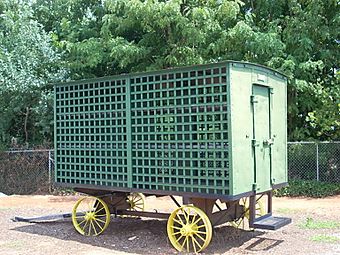Oconee County Cage facts for kids
Quick facts for kids |
|
|
Oconee County Cage
|
|

Oconee County Cage in 2009
|
|
| Location | Browns Square Drive., Walhalla, South Carolina |
|---|---|
| Area | less than one acre |
| MPS | Oconee County Penal System TR |
| NRHP reference No. | 82001523 |
| Added to NRHP | November 14, 1982 |
The Oconee County Cage is a very old "jail on wheels." You can find it on Browns Square Drive in Walhalla, South Carolina, USA. It's near the Oconee Heritage Center. This special cage was added to the National Register of Historic Places on November 14, 1982. It was listed along with the Oconee County Jail. When it was added, this cage was thought to be the most complete one of its kind in South Carolina. Today, Oconee County keeps the cage to help us remember the difficult conditions prisoners faced long ago.
Life in Early Jails
In the early 1900s, county jails in South Carolina mostly held people waiting for their court dates. These were people who couldn't pay bail to get out. If someone was found guilty, they usually had to do hard work on a county chain gang. Sometimes, they were sent to the state penitentiary.
Around 1916, most prisoners (about 94%) were on chain gangs. Only a small number (about 6%) went to the state prison. During this time, there was racial segregation. This meant that white prisoners were kept separate from African-American prisoners.
Instead of staying in a regular jail building, chain gangs lived in cages, cars, or tents. These were set up close to where they were working. The cages and cars could also be used to move the prisoners from one place to another.
History of the Cage
This specific "jail on wheels" was one of many used in the early 1900s. It helped house and move prisoners who were part of the chain gang. It was built around the year 1900.
In 1915, a state group reported on the chain gang. They said the gang was about 4 miles (6 km) from Seneca. The prisoners were fixing the Oconee Station Road. There were two cages. One cage held eight African-American men. The other held four white men.
Daily Life for Prisoners
The prisoners had simple meals. For breakfast, they ate bacon, biscuits, syrup, and coffee. Dinner was cabbage, bacon, and cornbread. Supper was bacon, biscuits, and syrup again. In 1917, reports said the cages had screens. By 1918, the chain gang only had African-American prisoners. White prisoners were kept at the regular jail or sent to the state prison.
Prisoners on the chain gang usually had short sentences. Most were for two months or less. Their families could visit them on weekends and bring food. One former prisoner remembered that everyone ate and talked together. This included the prisoners, guards, and their families.
By the 1930s, Oconee County started using gasoline-powered trucks. They also built a new, modern jail. Because of these changes, the old cages were no longer needed.
There's another similar "jail on wheels" in nearby Pickens County.
How the Cage Looks
The Oconee County Cage is a metal cage built on a frame with wheels. It's like a small wagon. Animals, like horses or mules, would pull it using a metal bar at the front.
The cage is about 14 feet (4.3 m) long, 8 feet (2.4 m) wide, and 7 feet (2.1 m) high. The front, top, and floor are made of solid metal. The sides of the cage have metal bars. These bars are crisscrossed with metal strips to form a grid. The back of the cage is solid metal and has a door that opens.
Inside the cage, there were four metal bunk beds. Each bunk bed had three sleeping spots, running along the sides. The beds had metal strips to hold bedding. In the middle of the cage, there was a metal barrel. This barrel was used for a fire to keep warm. In cold weather, canvas covers were used to close off the sides of the cage.



